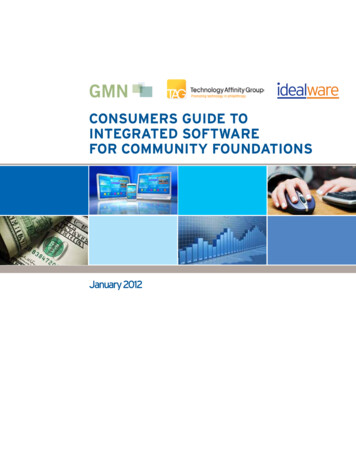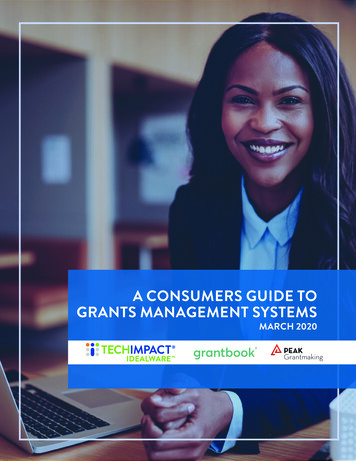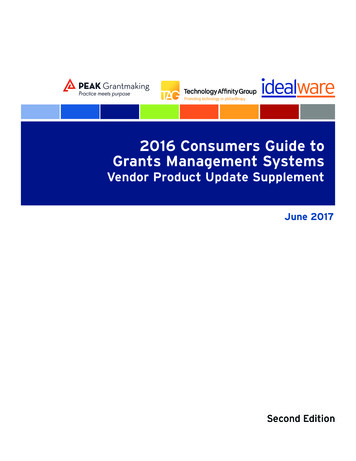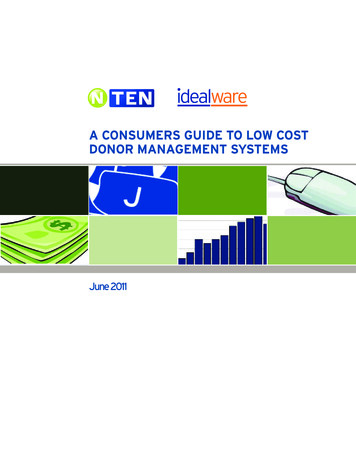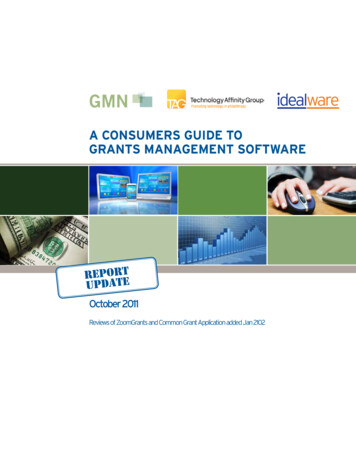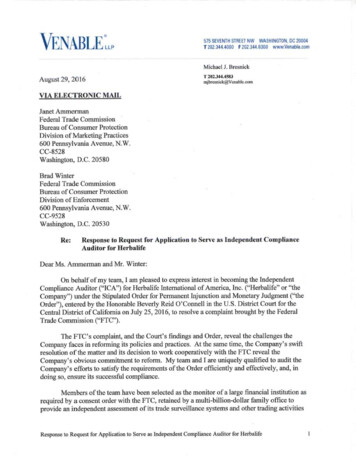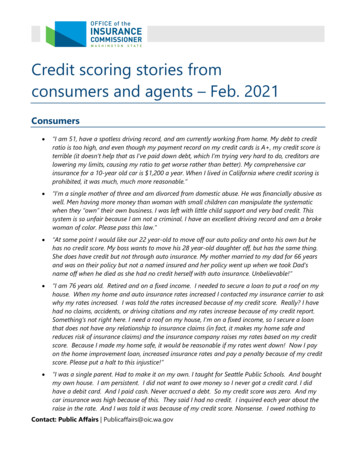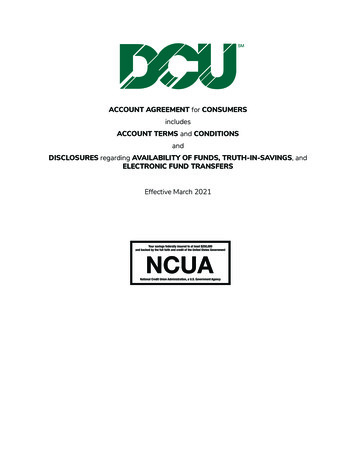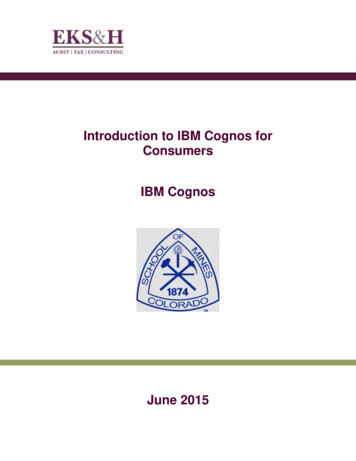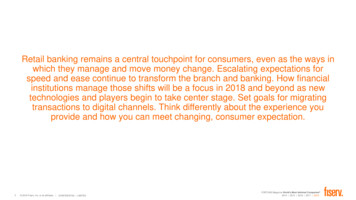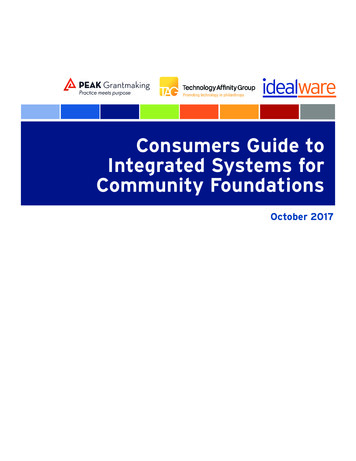
Transcription
Consumers Guide toIntegrated Systems forCommunity FoundationsOctober 2017
forewordDear Colleagues,PEAK Grantmaking and Technology Affinity Group (TAG) greatly appreciate the work that community foundations do across the country. We also recognize the difficulties and intricacies that exist within this segment of thephilanthropic sector. Regardless of the size of the organization, most community foundations are much morecomplex than their private foundation counterparts, having to provide donor services and manage multiple fundsin addition to traditional grantmaking activities. It can be overwhelming, especially if not equipped with the righttechnology.We are proud to sponsor this report, Consumers Guide to Integrated Systems for Community Foundations, created byIdealware. Technology can do so much, but selecting the right product is a pivotal part of ensuring your organization’s overall effectiveness. Not only will this report help you analyze your needs, but it also will help you decidewhich solution may best serve them.This guide covers a number of features and considerations, including: online applications, scholarships, donorportals, fund accounting, communications capabilities, support and training, and customer experience.We realize that identifying and selecting a solution that meets all of your needs can be a daunting task and we hopethis resource helps. We want to thank all the volunteers who contributed to the criteria development in this report.With so many potential options to consider, their help narrowing the scope was invaluable. We also thank thevendors for their time and contributions.Special thanks to Idealware for their dedication in giving the clearest view possible of such a complex landscape.Again, it is our sincere hope that this guide will help you evaluate the technology that’s available to you. We wouldappreciate hearing from you about the utility of this guide so we can have a continuing conversation on what is mostimportant to you. We also look forward to bringing you more compelling and valuable products and resources likethis in the future.Best regards,PEAK Grantmaking and Technology Affinity Group (TAG)PAGE2Consumers Guide to Integrated Systems for Community Foundations October 2017
How Was This Report Funded?This report was funded by the generous sponsorship of the Technology Affinity Group (TAG) and PEAK Grantmaking. Idealware was responsible for all of the research and editorial content of this report. Vendors of systems includedin our reports do not pay for inclusion, nor does Idealware accept any funding from vendors. Neither the funder northe vendors had any input over the editorial content of this report. We’re grateful for the support.Reprinting and QuotingFor information about reprinting, quoting, or repurposing this report, please read Idealware’s policy online 3Consumers Guide to Integrated Systems for Community Foundations October 2017
Table of contentsIntroduction. 5Do You Need a Community Foundation Solution?. 7What Do Community Foundation Solutions Do?. 8What Kinds of Systems Are Available?.20System Overviews. 21How Do The Systems Compare?. 24What Do These Systems Cost?.25What’s Included in These Systems?.28How Do You Decide?.29Detailed System Reviews.30Blackbaud FIMS (with GIFTS Online). 31Blackbaud Financial Edge NXT and The Raiser’s Edge NXT (with GIFTS Online).41Bromelkamp Community Akoya.net.51Bromelkamp Community Pearl.61Foundant CommunitySuite (with Grant Lifecycle Manager). 71Fusion Labs GE Spectrum.81GiftingNetwork GiftingNet.91Stellar Technology Solutions iPhi Suite. 101Appendices.111Appendix A: Research Methodology.112Appendix B: How We Evaluated the Systems. 114Appendix C: Customer Experience Survey . .126Appendix D: About this Report. 130PAGE4Consumers Guide to Integrated Systems for Community Foundations October 2017
introductionCommunity foundations operate quite differentlythan private foundations, and have a complex set ofadditional requirements to track their data. In addition to making grants, a typical community foundation also solicits donations, manages investments, actsas fiscal custodian for funds under advisement fromdonors, and awards scholarships. The experts we spoketo described community foundations as grantmakers,fundraisers and financial institutions all at once.Each of these roles requires something different of afoundation.As grantmakers, community foundations need totrack grant applications, review processes and makepayments, like all foundations. But their assets aretypically made up of dozens, or even hundreds, ofdifferent “funds” specifically earmarked by donorsfor a particular purpose. Each fund can have its ownrules, restrictions, and reporting requirements. In away, each fund can be viewed as a mini-foundation.As fundraisers, community foundations have the sameneeds as any nonprofit dependent upon gifts. Theyneed to be able to understand their relationships withprospects and donors, solicit them by mail and email,track complex gifts and grants, and understand whatfund each gift should go toward. They’ll also act asfiscal custodians of individual “donor-advised funds”for major donors who want to commit to ongoingphilanthropy. While the foundation has direct controlover these assets, donors often expect to be able toeasily check balances, view statements, deposit moneyand make grant recommendations for them—oftenonline.To complicate things further, the money under a community foundation’s management is often invested ina variety of investment vehicles, and the foundationmust keep track of how the investment income affectseach fund under its management.PAGE5Most of the systemswe reviewed meet thiscomplex set of needs byintegrating an ensemblecast of software. into asingle, comprehensivesolution.These requirements combine to make accountingparticularly complex, as well. Community foundationsneed to track incoming gifts, outgoing grants andinvestment income for each of potentially hundredsof different funds, and to be able to see the balanceof each more or less in real time. This feature makesdata integration across the organization particularlydesirable. If a foundation were to separate systems forfundraising, grants management, and fund accounting, integrating all the data for real-time fund balanceswould be extremely difficult.With a small number of potential customers—thereare only about 750 community foundations in theUnited States—and a complex set of requirements,only a few vendors provide solutions to address theseparticular needs.We reviewed 29 different grants management systemsfor private foundations in 2016 for A Consumers Guideto Grants Management Systems, but only eight systemsfrom six vendors met our requirements to qualify assolutions appropriate for community foundationsConsumers Guide to Integrated Systems for Community Foundations October 2017
for this report. By necessity, these vendors providemore than just standalone grants management systems—they provide integrated ecosystems intended tosupport all aspects of community foundations’ work.Most of the systems we reviewed meet this complexset of needs by integrating an ensemble cast of software, sometimes from different vendors, into a single,comprehensive solution. We compare them side byside in this report, evaluating each system by 199criteria grouped into five broad categories chosen todetermine how well the systems stacked up against theneeds of community foundations. Grant and Application Management Financial Management Donor Management Relationship and Communication Management Technical ConsiderationsWe also provide detailed summaries, a comparisonchart, and extensive reviews of all eight systems. In addition, we’ll publish a Vendor Product Update Supplement every 12 months until the next edition of thisreport as a means of allowing participating vendorsto share information about what’s been changed oradded to their systems. If you registered with Idealware, TAG, or PEAK Grantmaking to download thisreport, we’ll notify you when these supplements areavailable.Selecting a SystemWhich solution should you use? With a small poolof vendors to choose from, it’s tempting to wantto explore them all for your organization, but theircomplexity could make that an overwhelming task.Use this report to help you identify a few that aremost likely to be a great fit for your needs and budget.When trying to choose one of these systems, animportant consideration is how much functionalityis included out-of-the-box, and what functionalityrequires an additional module from the vendor or athird-party solution.PAGE6Some systems in this report (Bromelkamp Community Pearl, Foundant CommunitySuite, StellarTechnology Solutions iPhi Suite) provide almosteverything out-of-the-box for the quoted price, withthe exception of broadcast email, which requires athird-party solution such as MailChimp, ConstantContact, or VerticalResponse.Others (Blackbaud’s FIMS, Financial Edge NXT,Raiser’s Edge NXT, and GiftingNetwork’s GiftingNet)rely on additional products from the same vendor.For example, the two Blackbaud solutions we reviewin this report need GIFTS Online to support onlineapplications and Donor Central to support donorportals.The remaining system (Fusion Labs GE Spectrum)requires third-party solutions to support financialmanagement or donor management.For more detail on what functionality is includedwith each system in this report, consult the pricingchart on page 25. To see which specific functionalityrequires additional modules or third-party software,see the What’s Included in These Systems chart onpage 28 or check the detailed reviews of the systemsstarting on page 30.Then, consider a few questions to help you decide: These systems aren’t cheap—do the higher endsystems present a compelling return on investment for you? Do you need sophisticated fundraising functionality, or strong integrated broadcast email? Do you need a solution with robust fund accounting included, or are you satisfied with yourcurrent accounting system and want a solutionthat can integrate? And how important is it to provide your userswith a polished and integrated user experience?Consumers Guide to Integrated Systems for Community Foundations October 2017
Do You Need a Community FoundationSolution?Many community foundations manage their processeswith a set of un-integrated products—for example,a donor management system, a grants managementsystem, and a separate accounting system. Does itmake sense for to move to a specialized communityfoundation system instead?The most compelling reasons to switch are the needto tightly integrate data, or to provide more supportfor donor-advised funds. For instance: Are you having trouble determining the balanceof particular funds? Do you spend a substantial amount of timetrying to get data from one system into another,especially for accounting purposes?PAGE7 Are major donors asking for online portal functionality that you can’t provide, or can’t provideeasily, from your current setup?If you answered yes to any of these questions, thesolutions included in this report could be worththe investment. They all boast relatively seamlessintegration between different systems or modulesto provide comprehensive accounting data. And allhave integrated donor portals that can provide fundinformation approximately in real time.If streamlined data access between different areas offunctionality is important to you, you may find asystem that fits your needs among those reviewed inthis report.Consumers Guide to Integrated Systems for Community Foundations October 2017
What Do Community FoundationSolutions Do?It’s difficult to think about your own foundation’sneeds or evaluate the systems available to meet themwithout a solid understanding of what features arepossible, and which are common.Based on our interviews and our reviews, we learnedthat more is not always better—the right system foryour organization is the one that best supports yourneeds, not necessarily the one with the most features.Feature-rich solutions can also be needlessly complex,and may present an unnecessarily high learning curvefor your staff.To better understand the functionality provided byintegrated community foundation systems, we’vegrouped the features into five broad categories: Grant and Application Management, includingonline applications and review for competitivegrants to nonprofits and scholarships for students. Financial Management, including fund and grantpayment management and budgeting. Donor Management, including support for individual donations and online donor portals. Relationship and Communication Management,including support for letters, board dockets, andemail to groups or individuals. Technical Considerations, which include reportingcapabilities, user and permission management,data access, and overall customization.Not all systems cover all of these categories. Manycommunity foundations that find themselves lookingfor a new solution are really only seeking better support for one or two of these categories. Therefore, it’simportant to consider the specific functionality youneed rather than searching for a solution that checksall the boxes.PAGE8We recommend using this section of the report toconstruct a list of the features that might be useful toyour organization. From there, carefully prioritize thelist to fit your specific needs.Grant and ApplicationManagementThe functionality in this section is of particular importance to community foundations that maintain acompetitive grant program for nonprofit organizationsin their area or offer scholarship programs for currentor incoming college students.Online ApplicationsGrantmakers are increasingly accepting grant proposals online, but grants management software varieswidely in its support for online applications. Somesystems barely support them at all, while others arebuilt around them. When implemented thoughtfully,online applications can be an opportunity to streamline the application process for both grantmakers andgrantseekers by eliminating the need to manage paperproposals, ensuring all required information is complete upon submission, and automating compliancechecks and communications.Systems also can streamline the application processby limiting the information applicants are required toprovide until they are determined to be strong candidates for funding. Some systems include an interactivequalifying round, sometimes called an eligibility quiz,in which applicants answer a few questions to determine whether they’re eligible for funding before takingthe time to complete a more lengthy application.Consumers Guide to Integrated Systems for Community Foundations October 2017
Most allow at least a two-stage process that supportsboth an initial Letter of Intent and a more detailedproposal. If your application process contains multiplestages, check to see if the software will roll information from one stage to the next so grantees don’t haveto re-enter data as they move through the differentstages. Most systems also allow applicants to avoidredundant data entry by letting them reuse information from one application to the next. Some systemssupport branching capabilities in online forms tocollect different information from applicants based onthe information they provide.It’s critical to consider the experience of fillingout application forms from the perspective of thegrantseeker. For example, online forms can “time out”unexpectedly, losing all of the grantseeker’s work.Some systems mitigate this by automatically savingonline form entries at regular intervals. A few simplywarn users to save, while many others present a savebutton and rely on user diligence to make sure theydon’t lose any work. Applicants should also be ableto save incomplete applications and return to them.Most online application schemes let you use browserbased spell-checking to proof your work, but a fewpackages include built-in spell-checkers.Most systems allow grantees to register themselvesand set a user name and password. You can limit theregistrations by selectively sharing the web address.Some of the more advanced systems let prospectivegrantees set up multiple accounts for a single application—for example, to allow a financial staff memberto enter budget information—and transfer accounthistories between logins without contacting thefoundation or the vendor. A few even support submissions from other sources, such as references, that arekept invisible to the applicants.Most systems will allow applicants to upload attachments, in some cases including video or audiofiles—check if the file formats you need are supportedand that virus scans for such uploads conform to yourfoundation’s specifications.Once applications are submitted, applicants shouldreceive confirmation emails. Some systems let youcustomize the text of that email. Check to make sureapplication data flows seamlessly into the grantmakerinterface—if not, you’ll have to take the time to domanual data transfers.PAGE9You might also want the ability to collaborate withgrantseekers on applications in progress, and providecomments and feedback before the applications areeven submitted. Some systems will let you do so.Some allow applicants to check the status of theirrequests online as they move through the review p
Idealware. Technology can do so much, but selecting the right product is a pivotal part of ensuring your organiza- . We reviewed 29 different grants management systems for private foundations in 2016 for A Consumers Guide to G
